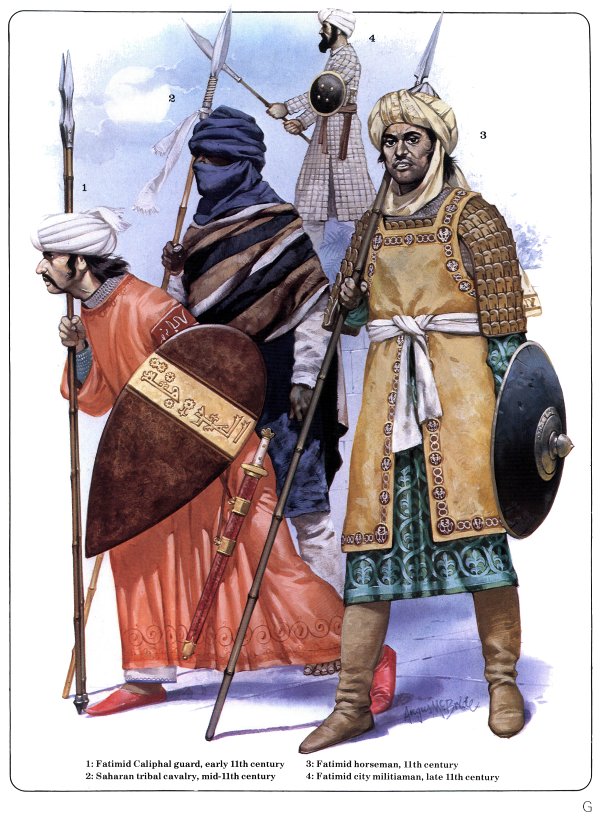
Create an Amazon Wedding Registry
Fatimids on Plate G
Men-At-Arms Series 125
The Armies of Islam 7th-11th Centuries
by David Nicolle & Angus McBride
 A larger image of Fatimid, plate G, MAA 125, 'The Armies of Islam 7th-11th Centuries', by David Nicolle & Angus McBride. |
G1: Fatimid Caliphal guard, early 11th century This man is probably of Daylami origin. He carries the two javelins traditional among his people, and also has the kite-shaped shield that was clearly known in the Middle East before it was carried there by the Normans of the First Crusade - such shields probably had a Byzantine origin. (Carved ivory panel, Louvre, Paris; ceramic fragment, Victoria and Albert Museum, London; painted paper fragments from Fustat, Museum of Islamic Art, Cairo and Louvre, Paris.) G2: Saharan tribal cavalry, mid 11th century The Berber nomads of the Sahara fought for all North African Muslim armies. Their dark blue face-covering turbans gave them the name of 'veiled men', and they were the cultural ancestors of today's Tuareg. (Paper fragment from Fustat, Museum of Islamic Art, Cairo; carved ablution basin, Archaeological Museum, Jativa, Spain; wooden panel from the Church of Sitt Barbara, Coptic Museum, Cairo.) G3: Fatimid horseman, 11th century The settled Arab and 'Arabized' peoples of North Africa and Egypt provided the Fatimid Caliphate with many cavalrymen. This man's equipment of iron helmet, mail hauberk and leather lamellar cuirass is within a well-established Muslim Middle Eastern tradition, but the cut of his surcoat shows a revival of older Coptic fashions under Fatimid rule. (Painted paper fragment, Keir Coll., London; Fatimid carved wooden panels, Museum of Islamic Art, Cairo and Louvre, Paris.) G4: Fatimid city militiaman, late 11th century The ahdath, or citizen militia, played a vital defensive rôle in many cities, though not apparently in Egypt itself. This man wears a quilted protective coat and wields an early form of glaive, probably the sabarbarah described in written sources. (Syrian Christian Gospel, British Library, London; carved wooden panels, Museum of Islamic Art, Cairo; carved ivory panels, Met. Museum New York, Episcopal Museum Le Puy, Victoria and Albert Museum, London; ceramic plaque from Sabra, Bardo Museum, Tunis.) |
Fatimid Illustrations of Soldiers and Hunters, 10th - 12th Centuries
